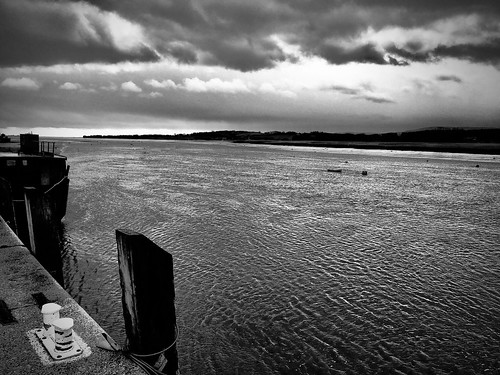
Early morning on the Topsham Quayside. So early it was still dark when we first arrived.
I'd left home wondering whether my ski jacket would be rather excessive for the little trip along the river. It turned out that my clothing was somewhere in the middle of the range selected by others.
Yes, we were going out on an RSPB Avocet Cruise. We'd be on the same boat that takes people across to the pub in sunnier weather, but today it would be used to seek out the wildlife along the Exe.
Armed with the identification card and a pair of binoculars, we could soon start to tick off the various species. Waders, Ducks, Gulls and 'Others'.

Fortunately we had a couple of very knowledgeable RSPB folk to provide a commentary, which only paused for a short time whilst a BBC Radio interview took place. We saw birds from all the main categories.
It started with avocets - that's the bird on the RSPB logo, where it also represents conservation. Avocets were almost gone from Britain but with improved wetland management they've made a strong comeback as evidenced in the RSPB picture below.

Then there was a collection of godwits. Black-tailed, I think our commentator said. They provide a kind of identification challenge being a wader that looks completely different in winter compared with its its summer plumage.

At this time of year many of the species are using the river for overwintering and the mud provides a rich source of food with a square metre of mud housing a bird-slurpable energy equivalent of a couple of KitKat fingers (at least I think that's what the RSPB chaps said). The smaller birds need about the calorific equivalent of a four finger KitKat per day, consumed in the form of tiny creatures from the mud. No wonder they look busy.
Then, for something like a cormorant, the river is a great source of eels and fish and with their efficient hunting technique they may only spend an hour a day fishing. One I saw threw its catch into the air, like a test cricketer catching a ball, before downing it in one. Showoff? Apparently the reason cormorants are often seen with their wings outstretched is because their wing feathers are not waterproof, which assists their fast diving. It means that the birds will stretch out to dry their wings whilst digesting their food. My picture here of a young cormorant is a cheat, because I took it in Santa Barbara, but I think it still illustrates the stretched wings.

There were plenty more to see, but I'll finish with the brent geese, which were flying around in huge squadrons. Apparently the apocryphal cooking method for a brent goose is to put it in a pot with an old boot. Boil for several hours, and then take out the brent goose and throw it away, instead eating the boot which will taste better.
I suspect the brent geese came up with this recipe themselves, as a form of protection. After all, they have to fly from England to Greenland or Siberia to raise their next family and even on the mudflats around the Exe it is still easy to discern their family units staying together. Here's another RSPB impression of them flying.

For us, when back at the boatyard, it was time to follow our excellent organiser Ange back to the Globe, for a still fairly early breakfast.
1 comment:
This sounds like a trip I'd enjoy :)
Post a Comment